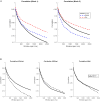A Minimal Turing Test: Reciprocal Sensorimotor Contingencies for Interaction Detection
- PMID: 32265679
- PMCID: PMC7105611
- DOI: 10.3389/fnhum.2020.00102
A Minimal Turing Test: Reciprocal Sensorimotor Contingencies for Interaction Detection
Erratum in
-
Corrigendum: A minimal Turing test: reciprocal sensorimotor contingencies for interaction detection.Front Hum Neurosci. 2024 Oct 17;18:1507296. doi: 10.3389/fnhum.2024.1507296. eCollection 2024. Front Hum Neurosci. 2024. PMID: 39483195 Free PMC article.
Abstract
In the classical Turing test, participants are challenged to tell whether they are interacting with another human being or with a machine. The way the interaction takes place is not direct, but a distant conversation through computer screen messages. Basic forms of interaction are face-to-face and embodied, context-dependent and based on the detection of reciprocal sensorimotor contingencies. Our idea is that interaction detection requires the integration of proprioceptive and interoceptive patterns with sensorimotor patterns, within quite short time lapses, so that they appear as mutually contingent, as reciprocal. In other words, the experience of interaction takes place when sensorimotor patterns are contingent upon one's own movements, and vice versa. I react to your movement, you react to mine. When I notice both components, I come to experience an interaction. Therefore, we designed a "minimal" Turing test to investigate how much information is required to detect these reciprocal sensorimotor contingencies. Using a new version of the perceptual crossing paradigm, we tested whether participants resorted to interaction detection to tell apart human from machine agents in repeated encounters with these agents. In two studies, we presented participants with movements of a human agent, either online or offline, and movements of a computerized oscillatory agent in three different blocks. In each block, either auditory or audiovisual feedback was provided along each trial. Analysis of participants' explicit responses and of the implicit information subsumed in the dynamics of their series will reveal evidence that participants use the reciprocal sensorimotor contingencies within short time windows. For a machine to pass this minimal Turing test, it should be able to generate this sort of reciprocal contingencies.
Keywords: Turing test; interaction; perceptual crossing; reciprocity; sensorimotor contingencies.
Copyright © 2020 Barone, Bedia and Gomila.
Conflict of interest statement
The authors declare that the research was conducted in the absence of any commercial or financial relationships that could be construed as a potential conflict of interest.
Figures












References
-
- Auvray M., Lenay C., Stewart J. (2009). Perceptual interactions in a minimalist virtual environment. New Ideas Psychol. 27 32–47. 10.1016/j.newideapsych.2007.12.002 - DOI
-
- Bahrick L. E., Lickliter R. (2012). “The role of intersensory redundacy in early perceptual, cognitive, and social development,” in Multisensory Development, eds Bremner A. J., Lewkowicz D. J., Spence C. (Oxford: Oxford University Press; ), 183–205.
-
- Berkovits I., Hancock G. R., Nevitt J. (2000). Bootstrap resampling approaches for repeated measure designs: relative robustness to sphericity and normality violations. Educ. Psychol. Meas. 60 877–892. 10.1177/00131640021970961 - DOI
LinkOut - more resources
Full Text Sources

